Text | Essay | Gropius Bau 2022
Landscapes seen as Chemistry
By Lili Carr with photographs from Fred Walkow

Heavily polluted in the 20th century, the town of Bitterfeld is now held up as the poster child for green regeneration. But the swamp of chemical toxins was simply contained underground in what locals call “the bubble”. How long can this containment last? Architect, researcher and member of Feral Atlas, Lili Carr, investigates caring for a landscape forever threatened by its industrial past.
Subsurface realms are a hot mess of biological, chemical and hydrogeological activities that, buried out-of-sight, trouble attempts at apprehending them. A post-mining, post-industrial subsurface that resists remediation in Bitterfeld, Saxony-Anhalt, requires a close and sustained attendance, in particular to the uncertain dynamics of its life-threatening chemical loads. Based on a three-month archival residency at Bitterfeld’s Kreismuseum (1) and in conversation with the former head of the city’s environmental agency, Dr. Fred Walkow, this piece witnesses various hydrogeochemical goings-on within a landscape whose more-than-human activities, politics and histories have shaped and are being shaped by chemistry.
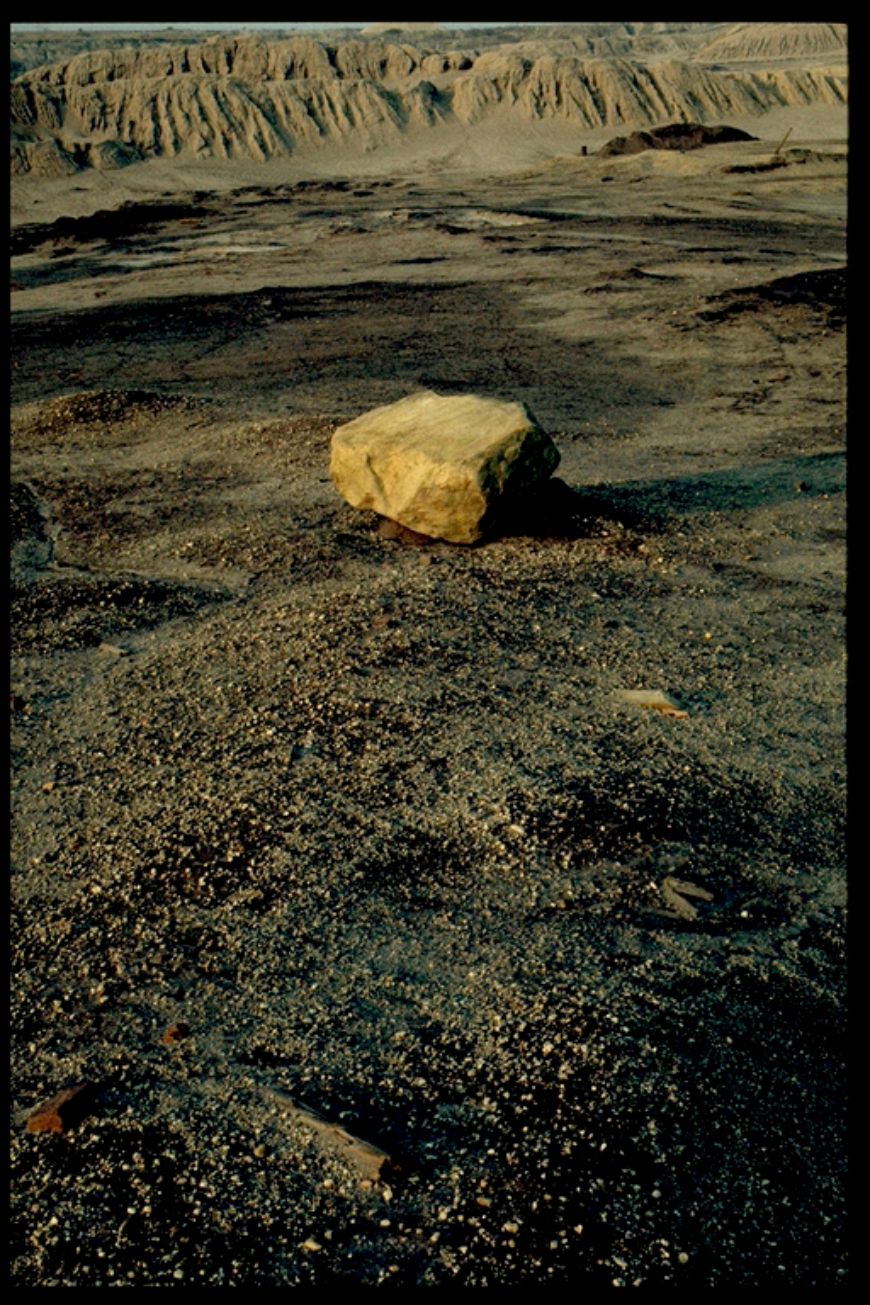
From the south-east corner of Bitterfeld extends the Goitzsche, a replanted recreational forest area that is flanked by the Goitzschesee, one of the region’s recently flooded recreational lakes. There has not always been a forest here although earlier accounts of the region describe one. (2) This is a landscape that has been made over and over, a place to study what anthropologist Anna Lowenhaupt Tsing terms “bare-ground ecohistories”; histories in which humans and nonhumans work to remake a radically altered landscape anew. (3)
Standing on the shore of the Goitzschesee I am hard-pressed to know, viscerally and sensorially, that the ground datum I now stand at was once the gaping-hole of a pit mine. A lignite seam was discovered running close to the surface in Bitterfeld in the late 17th century and by the mid 19th century, following the invention of the steam-powered groundwater pump, large-scale mining operations were well underway. The first lignite mines opened along the town’s north-west flank and as the demand for the material grew throughout the twentieth century, successively larger pits were opened in an anti-clockwise direction around the city’s residential areas until the closure of the final east-side pits, including the Goitzsche, in 1992. At the turn of the twentieth century, four chemical factories, including the Filmfabrik and the Farbenfabrik, opened along the western edge of Bitterfeld and the adjacent town of Wolfen, attracted by the proximity to lignite-power, mineral resources, water, labour, rail and the already depleted west-side pits available for the dumping of industrial waste. By the mid-1980s, these factories’ production amounted to 4500 industrial and household goods, including plastics, synthetic fibres, pesticides, metals, inks and dyes, photographic film, pharmaceuticals, phosphorus and chlorine. By the time of their closure in the years following reunification, one hundred years of solid and liquid by-products from each of their production processes had poured into these pits. (4)
Today, new chemical industries operate on top of these former factory sites, attracted by the legacy of infrastructural hardware, mineral resources, water, labour, rail, local political favour and on condition of the state-funded remediation of toxic ground (5). Meanwhile throughout residential Bitterfeld and the Goitzsche, groundwater monitoring wells, “pump and treat” plants and subsurface containment walls attempt to track, remove or contain their inheritance of industrial chemical toxins whose life spans range from decades to centuries.
%20in%20the%20Goitzsche.jpg)
Fred Walkow, a chemist and former employee of the Filmfabrik Wolfen from 1975 to 1990, and subsequently head of Bitterfeld’s environment agency from 1990 to 2015, showed me a series of photographs he took around Bitterfeld between the late eighties and early nineties. One of these captures a breach of groundwater bursting up from the subsurface beneath a depleted and partially flooded mine. Since the town’s lignite lay beneath the water table, mining required a continuous pumping of water which would otherwise fill the pits. As groundwater was pumped and discharged to the river Mulde, digging radically upset a carefully layered and stable stratigraphy. The water-impermeable layers of clay that once held the region’s two aquifers were removed to access the lignite, while exhausted pits were filled with water-permeable overburden consisting of unwanted sands and sediments. No longer held apart by their geology, what was once two horizontally distinct yet adjacent bodies of groundwater is now a partially connected and tentacular mass that leaks and leaches where hydrostatic pressure and gravity dictates.
Several of these flow-ways incorporate the dumps. A cocktail of chlorinated hydrocarbons – with their precursors and by-products – are picked up by Bitterfeld’s groundwater as it passes through the chemical dumps in the west on its easterly flow through residential Bitterfeld towards the Mulde. Known quantities are mixed with unknown compounds from an undetermined variety of unresolved sources; twentieth century industrial residuals mix with the products of past and present-day multi-stage, multi-durational thermodynamic and metabolic processes. Aiding in this ceaseless remaking of its environment, the city’s groundwater takes on this load of human and non-human material histories; mineral, chemical and microbiological byproducts whose presence, let alone their mechanisms of production and interaction, are wildly uncertain if not unknown (6).
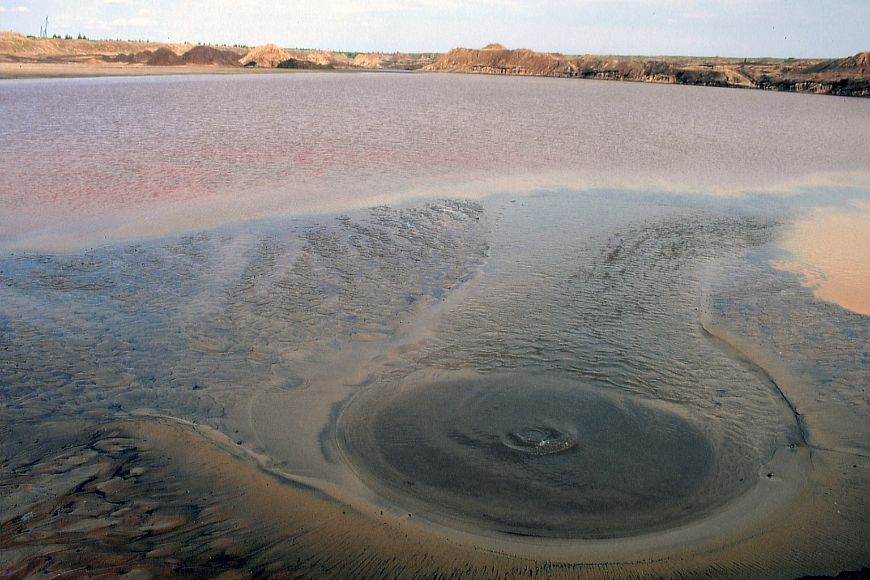
Liegenddurchbruch Niemegker Loch. “Groundwater from a pressurised aquifer breaches through an impounding stratum, often composed of clay or loam.” ~FW © Fred Walkow
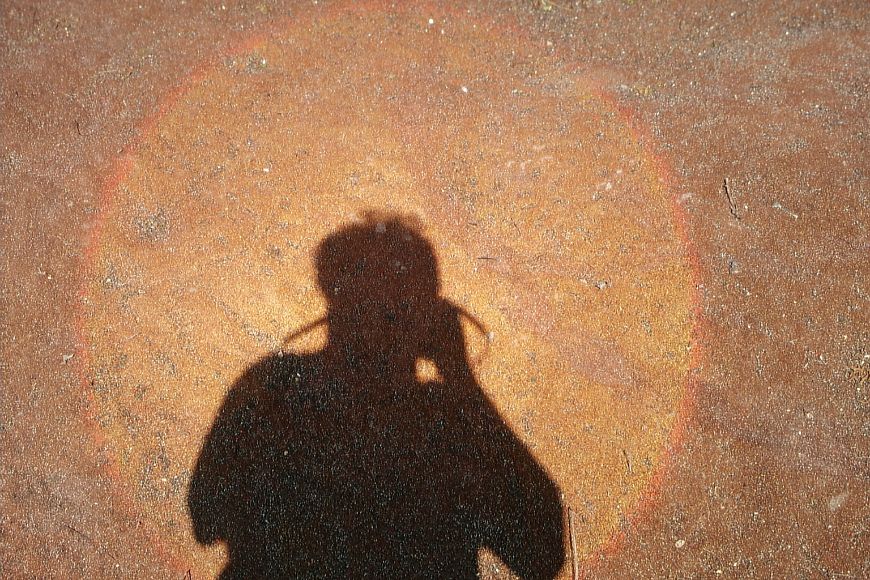
Shadows in ion exchangers. “Ion exchangers have been produced in Bitterfeld for decades until the present day. In the GDR, the Chemiekombinat Bitterfeld was the main producer of ion exchangers. Faulty batches were washed away via the canal system and some of this material settled on the banks of the Spittelwasser, forming deposits up to 50cm deep. Due to their organic polymer backbone, ion exchangers absorb organic pollutants of all kinds in considerable quantities. The removal of the ion exchangers at Spittelwasser was the first environmental remediation measure in Bitterfeld, and the only successful remediation measure to this day outside of the Bitterfeld Chemical Park. Many television crews filmed the work. The spherical ion exchangers scatter sunlight and create a circular halo when the sun is behind the viewer.” ~FW © Fred Walkow
The chemical species that are known, at least those that are most stable (with the longest of half-lives) and which pose a particular threat to human health, are tracked and monitored through the array of over 800 groundwater monitoring wells positioned through the Goitzsche and across the residential areas of Bitterfeld. Each well is calibrated to measure these chemicals such that any movements can be detected and containment measures enacted.
Bitterfelders call this aquiferous and concentrated mass of chemical species “Blase”, or “the bubble”. Someone I spoke to during my time in Bitterfeld talked about living above this “bubble”, that in order for them (or anyone) to remain there, care must be taken of it and its subtle movements closely attended to. This is necessary to ensure that chemical toxins don’t evade containment and encroach on a basement, or flow into the Mulde. The Federal Government and the State of Saxony-Anhalt fund this monitoring work (7) alongside the work required to maintain Bitterfeld’s “pump and treat” plants that keep the contaminated groundwater from seeping into uncontaminated areas, while a system of canals and the remedial flooding of the east-side pits keep it from flowing in the direction of the Goitzsche. In many ways, caring for Bitterfeld’s subsurface seems not much different from the mundane necessity of providing potable tap water or light or heat; a matter of public utility that must be maintained in perpetuity, with a budget of fifteen million euros a year.
In this, as with its naming and in its drawing (a hard-edged polygon overlaid across a plan-view of Bitterfeld), the figure of “the bubble” offers a reassuring and localised notion of containment, albeit with the hint of a threat: held under pressure, bubbles can burst. However, Bitterfeld’s groundwater contamination is neither contained, nor immediately threatening to escape containment. A more accurate description would be a diffuse subsurface gradient across relative thresholds of contamination, whose invisible interactions outside of these thresholds and beyond visible concerns are already out of containment and control (8).
The carcinogen vinyl chloride, produced from trichloroethene (9) in the metabolic activities of subsurface chemotrophic microbes, has recently been detected in groundwater outside of the area zoned by “the bubble” (10). Surface contamination spreads also. The pesticide and persistent organic pollutant lindane, discharged directly into the river Mulde through the 1980s and dispersed across surface soils with each flooding event, bioaccumulates in grazing deer and boar and has been detected as far as the North Sea. Unwittingly sealed to groundwater flow by its hardened lignin sludge, but deemed too expensive to attempt to clean up or remove (to where?), a project is underway to bury the Silbersee, the unsealed pit mine turned dump for the Filmfabrik Wolfen, by filling it with slag made from incinerated household waste. However, the relative slowness of household waste production (it will take an estimated 15 years to fill the pit) and a warming climate (which has triggered the production of a noxious odour), has put the project on indefinite hold.
In the coordinations between human alterations of the subsurface and non-human worldmaking activities, in the pits, in the soil, transported by subsurface flow-ways and by the bodies of surface-dwelling organisms, entirely new and uncertain landscapes are being shaped within Bitterfeld’s filled and levelled grounds (11).
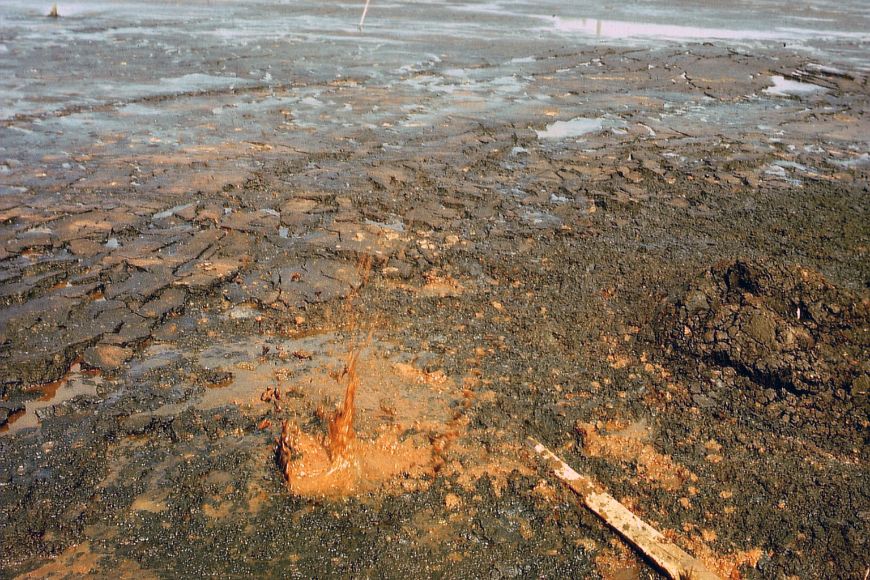
Mud in the Silbersee. “The Silver Lake (Silbersee) was the sedimentation basin of the Filmfabrik Wolfen. The sludge consists of residues from cellulose fibre production. The main component of the sludge is lignin. The starting material for fibre production is beech wood. In order to obtain cellulose, the lignin, which is unsuitable for fibre production, had to be separated. To do this, the lignin was converted into a water-soluble form which was then flushed into the Silbersee. Solid lignin formed there again and settled as sludge. The surface of the sludge is black due to oxidation of atmospheric oxygen. The splash at the bottom left of the photo was created by a rock thrown to show the yellow colour of the mud.” ~FW © Fred Walkow
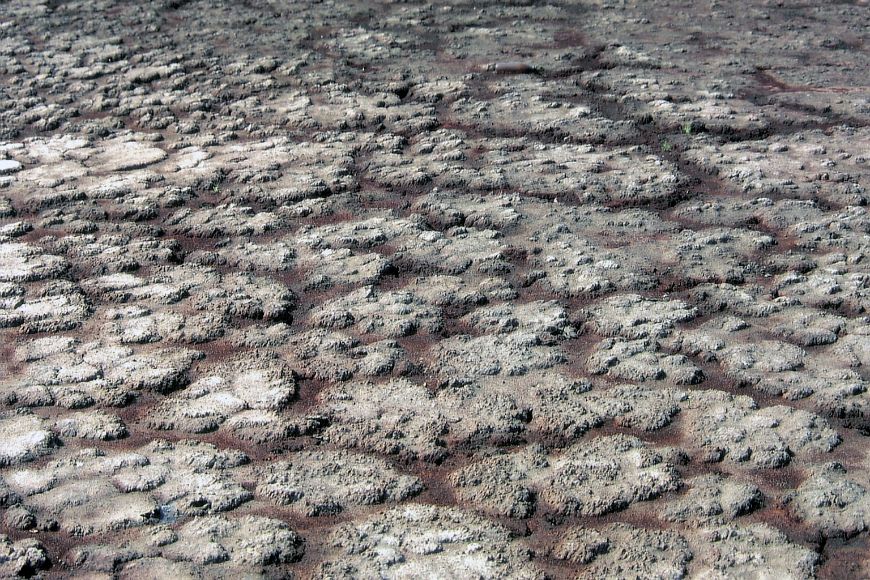
Schlamm Grube Greppin. “Grube Greppin, a former open pit mine, was the tailing pond/sedimentation basin of the Farbenfabrik Wolfen (Dye factory). To this day the pit contains a large number of unknown residues from dye production.”~FW © Fred Walkow
%20in%20the%20Leine%20Canal.jpg)
Fred Walkow and I look at a series of closely framed photographs of groundscapes in which an orange particulate substance floods most of the scenes. The substance, Fred Walkow tells me, is red ochre, formed once again in the more-than-human coordination of mining, microbial and hydrogeological activities.
He calls these photographs scenes of “visible geochemistry in-action” and I am interested in them precisely because they are not the sensational scenes of industrial ruin – of industrial dumps piled high or the large-scale leaking of chemical affluent across a damaged landscape – that have come to define GDR-era Bitterfeld (12). We look at those images too, many of his were published in the national and international press following reunification and were instrumental in rapidly mobilising remediation efforts (13). Urgent and essential in their spectacular nature at the time, now we might see their shocking scenes of damage as incommensurable with the infilled and remediated grounds of the Goitzsche to which “unbridled life and unspoilt nature” (14) has returned. In these contemporary scenes landscaping and language appear as a balm in which chemical loads and uncomfortable histories are pushed out of sight and out of mind beneath the surface of a filled and flattened ground.
The binaries of visible/invisible, exposed/buried, uncontained/contained, contaminated/clean and before/after propagated by promoters of modernisation might lead us to assume that (most of) the environmental violence inflicted on and within Bitterfeld’s landscapes is an event of the past; that such damage can be reversed through remediation and that 21st century techno-chemical industrial ways of doing are the solution to the problems 20th century industry caused. However as argued by others (15) concerning chemically contaminated sites elsewhere, the visual remediation of Bitterfeld’s landscape sustains modernist myth-building that deflect from the urgency of seeking alternatives to contaminating practices in the first place, both absolving industry from the responsibility of its landscape damaging programmes while sustaining the infrastructures of toxic release and harm.
I am told that in Bitterfeld there is a word, Chemiebewußtsein, which translates to “chemical awareness”; the condition of living and working in landscapes that continue to be configured by chemistry. Perhaps then the more ambiguous scenes of “visible geochemistry” in these photographs offer a more useful orientation within Bitterfeld’s landscapes today, since they gesture towards those uncertain and incalculable scenes of invisible hydrogeochemical going-ons that will continue to shape conditions of living in Bitterfeld and with Bitterfeld’s ground long into the future. Perhaps attuning to the forms of visuality produced by the ground itself (in this instance, red ochre) can trouble our reliance on hegemonic forms of visualising landscapes and in doing, open the possibility for inquiry, imagination and reckoning with what is required to live and work with and within such damaged landscapes, especially when what is at stake is the very possibility of living at all.
Lili Carr (she/her) is an architect and landscape architect-in-training. Recently published projects include 'Vegetation under Power', curated as part of Bauhaus Lab 2021 at the Bauhaus Dessau Foundation in Saxony-Anhalt, and Feral Atlas (Stanford University Press, 2020), as part of Feral Atlas Collective. Her most recent writings have been published in Perspecta, Kerb Journal, The Architectural Review, Making Matters (Verlag, 2021) and Vegetation under Power (Spector Books, 2022).
Endnotes:
1 With thanks to the Bauhaus Dessau Foundation and Bauhaus Lab 2021.
2 The archives of the Kreismuseum, Bitterfeld, hold photographic documentation of various forests that have inhabited the geographic area of the Goitzsche, from a photographic series of logging in the Goitzsche (unknown photographer, Eiche 200 Jahre alt, die große Eiche der Goitzsche, 1936), to a photographic series of ~8000 year old bog oaks found during mining operations in the Goitzsche (D. Brandt, Fund und bergung der Mooreichen ca. 8000 Jahre alt, Tagebau Goitzsche, 1976).
3 Anna L. Tsing, “When the Things We Study Respond to Each Other,” in More-than-Human, ed. Andrés Jaque et. al (Rotterdam: Het Nieuwe Instituut, 2020), pp. 16–26, here p. 23.
4 This is an all-too-concise second-hand overview of Bitterfeld’s complex industrial history. There are numerous books and papers telling more thorough accounts. This is adapted from Reiner Stollberg, “Groundwater Contaminant Source Zone Identification at an Industrial and Abandoned Mining Site: A Forensic Backward-In-Time Modelling Approach,” (PhD diss., Martin Luther University Halle-Wittenberg, 2013). See also Sandra Chaney, “A chemical landscape transformed: Bitterfeld, Germany since 1980,” Global Environment Vol. 10, Issue 1 (2017): pp. 137–167.
5 The environmental framework law (Umweltrahmengesetz und das Hemmnisbeseitigungsgesetz) was enacted in June 1990, which allows investors and owners of contaminated properties to be "exempted" from the risks of contaminated sites caused before July 1st, 1990. See “Landesanstalt für Altlastenfreistellung”, Landesanstalt für Altlastenfreistellung des Landes Sachsen-Anhalt (LAF), accessed November 14th, 2022.
6 F. Walkow explains that chemists have little way of knowing the particularities of reaction pathways taking place in the ground: “When you release chemical compounds into the environment, you start a cascade of chemical reactions until they are transformed into the thermodynamically most stable end-products, without knowing which intermediate products are formed in the process and how these interact with the environment. The reactions in living organisms are often very different from those in a reaction vessel and lead to compounds never industrially manufactured by humans.”
7 Work managed by the LAF.
8 See Anna L. Tsing, Jennifer Deger, Alder Keleman Saxena and Feifei Zhou, Feral Atlas: The More-Than-Human Anthropocene (Redwood City: Stanford University Press 2021).
9 F. Walkow explains: “Vinyl chloride is the starting product for polyvinyl chloride (PVC), the first human-made polymeric material. In the groundwater of Bitterfeld vinyl chloride is produced in the twofold microbiological hydro-dechlorination of trichloroethene, a chlorinated hydrocarbon known as Tri. Tri is a liquid ethane derivative with three chlorine atoms, used as a degreaser for machines and clothes through dry cleaning. Tri is widespread in the groundwater throughout the western world.”
10 “Ergebnisbericht zum Grund- und Oberflächenwassermonitoring im ÖGP Bitterfeld-Wolfen für das Berichtsjahr 2017”, Im Auftrag der Landesanstalt für Altlastenfreistellung Sachsen-Anhalt, unveröff. Bericht, 26.04.2019. Obtained via a freedom of information request from the LAF.
11 I’ve written about this elsewhere. See Stiftung Bauhaus Dessau, Bauhaus Taschenbuch 26: Vegetation under Power, Heat! Breath! Growth! (Leipzig: Spector Books, 2022).
12 See Sabine Adler, “Giftiges Erbe in Bitterfeld-Wolfen”, Deutschlandfunk, April 8th, 2019. See also Christiane Kohl, “Die Leute werden dun im Kopf”, Der Spiegel, January 7th, 1990, .
13 Such as the 1992 Bitterfelder Umweltkonferenz. See Fred Walkow et. al, Bitterfeld: Modellhafte ökologische Bestandsaufnahme einer kontaminierten Industrieregion—Beiträge der 1. Bitterfelder Umweltkonferenz (Berlin: Erich Schmidt Verlag GmbH & Co, 1992).
14 See “Goitzsche-Wildnis”, BUND: Friends of the Earth Germany, accessed November 14th, 2022.
15 Nicholas Shapiro and Eben Kirksey, “Chemo-Ethnography: An Introduction,” Cultural Anthropology 32, no. 4 (2017): pp 481–493, 2017.